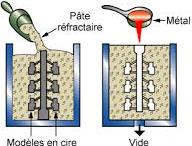Unlike iron and steel silver and copper are not forged hot, but when they are cold. They become hard by hammering, and therefore brittle and fragile. They should regularly during the operation be heated (annealed) again and cooled down to get the stress out of material and keep it deformable and hold soft.
Silversmithing is labor intensive. Many techniques have been supplanted by machine pressing, forming and folding. Some craftsmen and many hobbyists ensure that all knowledge is not lost.
 In these techniques, no material is added or taken away.
In these techniques, no material is added or taken away.
Hammering: hit with hammers in shape, planishing
Chasing and repoussé: strike with punches (small rounded chisels) in shape
Raising: stretching, deepening the surface (by hammering or punching)
Upsetting: compacting material (the head of a pulled nail is swaged to the wire), material compaction, reducing workpiece.
Embossing: giving relief shapes with sharp punches, decorative denting.
Spinning: method to obtain 3 -D objects (mechanically) from flat plates, e.g. tins, cartridge cases.
Plates, pans, kettles, cups (sports trophies) can be made from a flat plate.
Drawing
In order to draw wire, a rod or big wire is drawn through a series of increasingly smaller holes. The reduction of the diameter of the wire may go up to 45 percent per pass at room temperature. The wire is hot and stronger by the deformation by pulling it trough the mold. After treatment in a hot (lead) bath it can be made smooth again. By pulling 5.5mm x 1m can transform into e.g. 190 m x 0.5 mm.
“Better wear out than rust away.”(Richard Cumberland)
Hammering a bowl
Cut or saw a disk of which the diameter corresponds to the bottom and 2x the height of the workpiece. May be slightly smaller, the material stretches. Glow them. Draw the bottom and as guides concentric circles around it. Strike what the upstanding side must be on a wooden cutout in wave shape, like the edge of a cake tin. By this the edge comes somewhat upwards.
Thereafter, further hammering on a round pole, with the flat bottom at the point of the stake. Try to strike always around, and some spiraling upwards to work it out. Note that every spot is hammered close together. Then again annealing, and start again until the desired shape is achieved. With a flat (planing) hammer the dents can be smoothed. Possibly finishing with sanding and polishing. One with sand filled leather cushion is sufficiently strong and malleable to various forms to serve as anvil.
Spinning copper
Since 1900 many household copper was machined by spinning. A wooden or metal model was clamped at the base of the lathe, along with a copper plate. With a piece of wood or steel, the fast rotating plate under regular annealing was pushed back to the form. Later, a copper sheet was pressed into an object under high pressure between two steel models.
Copper turning
A workpiece is clamped on a lathe and rotated fast. With steel chisels were now removed or machined metal.
Copper pressing
With rolls thinner sheets are rolled or pressed for roofing or gutters.
Casting in molds of sand and loam or (rinsed and dried) cuttlefish (Sepia officinalis): white, inside soft inner shell of the cuttlefish used in birdcages as lime food. You can easily press a shape (ring,...) in it.
Cire perdue (lost wax, or actually lost form)
 The form that you want to pour you first make easily in wax. To create a cavity you can build it on a surface (cylinder) of clay. For larger pieces, you provide the necessary stainless steel connections between inside and outside. The soft wax can easily be finished fine, decorated and corrected. Around it you model (refractory) gypsum (and fireclay) in which you provide vent channels and a feed hopper. This dried form you put upside down in an oven so that all the wax (at about 65°C) can run out. Then fry the form refractory at 1,200°C. You can then cast molten metal (e.g. bronze) in it. To get it out later you have to smash the (lost) form. So you get a unique specimen.
The form that you want to pour you first make easily in wax. To create a cavity you can build it on a surface (cylinder) of clay. For larger pieces, you provide the necessary stainless steel connections between inside and outside. The soft wax can easily be finished fine, decorated and corrected. Around it you model (refractory) gypsum (and fireclay) in which you provide vent channels and a feed hopper. This dried form you put upside down in an oven so that all the wax (at about 65°C) can run out. Then fry the form refractory at 1,200°C. You can then cast molten metal (e.g. bronze) in it. To get it out later you have to smash the (lost) form. So you get a unique specimen.
If you want to reuse it to pour the same items (e.g. cups...) you have to make a mold of 2 or more matching pieces (with semicircular pins and holes for correct positioning).
On drawings of old workshops you often see on the window glass balls. They were not to look into the future, but to concentrate enough light on the work. A clear bottle with pure water has a similar effect. The PET bottles in densely populated Philippine slums stabbing through the roof give during the day as much light as an incandescent bulb.
http://nl.wikipedia.org/wiki/Overzicht_van_historische_edelsmeedtechnieken
